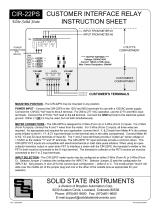
FUSES - Fuse F5 in the utility's compartment is coordinated (in series) with the customer's fuse F1. Fuse F6 is
similarly coordinated with F2. F1 and F2 are factory-equipped at 1/4th Amp. F5 and F6 are factory equipped at
1/2 Amp. F5 and F6 are designed to protect the CIR-24PS's circuit boards in the event that fuses larger than 1/
2 Amp are used by the customer in the F1 and F2 positions. F3 and F4, which protect Utility outputs #3 and #4,
are also factory equipped at 1/2 Amp. Maximum fuse ratings are designated on the silkscreen under or
adjacent to each fuse position.
CUSTOMER OUTPUTS - Two outputs are provided for CUSTOMER use. The terminals for these two outputs
are located in the bottom of the enclosure in the customer compartment and are marked K1, Y1 and Z1 for
Output #1 and K2, Y2, and Z2 for Output #2. Each K-Y input (connection between the K and Y input terminals)
will cause a K-Y output of the same channel. A K-Z input (connection between the K and Z input terminals) will
result in a K-Z output. Outputs are dry-contact type and must be provided with an external voltage of up to
250VAC/VDC on the K terminal by the customer's equipment. Maximum current through the solid state switch
is 500mA. Arc suppression for the contacts of the solid state relays are provided internally. There is
approximately 2.5 ohms of on-state resistance across the relay outputs.
UTILITY OUTPUTS - Two outputs are provided for UTILITY use, one corresponding to each input. The output
terminals are located in the top of the enclosure in the utility compartment and are marked K3, Y3 and Z3 for the
first output and K4, Y4, and Z4 for the second output. Each K-Y input (connection between the K and Y input
terminals) will cause a K-Y output of the same channel. A K-Z input (connection between the K and Z input
terminals) will result in a K-Z output. Outputs are dry-contact type and must be provided with an external
voltage of up to 250VAC/VDC on the K terminal by the customer's equipment. Maximum current through the
solid state switch is 500mA. Arc suppression for the contacts of the solid state relays are provided internally.
There is approximately 2.5 ohms of on-state resistance across the relay outputs.
OUTPUTS - Four three-wire isolated outputs are provided on the CIR-24PS, with output terminals K1, Y1 & Z1;
K2, Y2, & Z2; K3, Y3 & Z3; and K4, Y4 & Z4. Each output is rated at 250VAC/VDC MAX and current limited to
500mA (1/2 Amp). Arc suppression for the contacts of the solid state relays are provided internally. Each relay
must be assigned to one of the two input channels. Using the A-B Selector Switches, select "A" for input
number 1, or "B" for input number 2. Each relay's output will follow the input selected. The CIR-24PS' outputs
may be configured for either Long or Short output pulses. Selector Jumper J3 selects the long or short output
configuration for all outputs set to INPUT #1. Selector Jumper J4 sets the long or short output configuration for
all outputs set to INPUT #2. Put the Jumper Plug in the correct position for the output type desired. See Page 3
for more information on Long and Short output modes.
SOLID STATE INSTRUMENTS
a division of Brayden Automation Corp.
6230 Aviation Circle, Loveland, Colorado 80538
Phone: (970)461-9600
MAXIMUM POWER DISSIPATION OF OUTPUTS - Output devices are rated at a maximum of 50VA. Care
should be taken to insure that the wetting voltage used across the output device times the current (or burden) of
the input of the downstream device, does not exceed the maximum power output dissipation of 50W. Normally
this is not a problem since most downstream instrumentation devices are high impedience and present a very
low burden, usually less than 10mA. For example, if 240VAC is used, the maximum allowable current across
the output is 208mA. If 12VDC is used, the maximum current allowable across the output is approximately
4.15A, however 4.15 Amps is clearly beyond the 1/2A rating of the device. Therefore, the maximum
dissipation when using 12V is 6VA since the current is limited to 1/2 amp. Calculate the maximum current using
the following formula: 50Watts / Voltage = Max. Current (burden). Adjust the voltage or current used across
the output to insure that the maximum power dissipation, voltage and current maximums are not exceeded.



